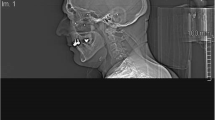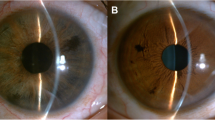Abstract
A 47-year-old man presented with a perforating open globe injury of the left eye following a tire explosion. Upon examination, a Zone I full-thickness corneal laceration with lens violation was noted on examination. Orbital computed tomography (CT) imaging showed a “U-shaped” radio-opaque intraocular foreign body (IOFB). After repair of the Zone I corneal laceration, pars plana lensectomy and vitrectomy was performed. However, the IOFB was unable to be located during vitrectomy. Further exploration revealed a posterior scleral exit wound with the metallic foreign body straddling the sclera. This case demonstrates that extraocular migration of IOFBs may occur during vitrectomy due to intraocular pressurization and an occult exit wound where the IOFB retracted into the globe. Perforating through-and-through injuries should be suspected if the IOFB cannot be identified during vitrectomy. The patient subsequently underwent pupilloplasty and a scleral fixated intraocular lens 1 year later, and vision improved from presenting vision of hand motions to 20/25 at 3 years of follow-up.
Access this chapter
Tax calculation will be finalised at checkout
Purchases are for personal use only
Similar content being viewed by others
References
Loporchio D, Mukkamala L, Gorukanti K, Zarbin M, Langer P, Bhagat N. Intraocular foreign bodies: a review. Surv Ophthalmol. 2016;61(5):582–96. https://doi.org/10.1016/j.survophthal.2016.03.005.
Jonas JB, Knorr HL, Budde WM. Prognostic factors in ocular injuries caused by intraocular or retrobulbar foreign bodies. Ophthalmology. 2000;107(5):823–8.
Zhang Y, Zhang M, Jiang C, Qiu HY. Intraocular foreign bodies in china: clinical characteristics, prognostic factors, and visual outcomes in 1,421 eyes. Am J Ophthalmol. 2011;152(1):66–73.e1. https://doi.org/10.1016/j.ajo.2011.01.014.
Fulcher TP, McNab AA, Sullivan TJ. Clinical features and management of intraorbital foreign bodies. Ophthalmology. 2002;109(3):494–500.
Potts AM, Distler JA. Shape factor in the penetration of intraocular foreign bodies. Am J Ophthalmol. 1985;100(1):183–7.
Lit ES, Young LHY. Anterior and posterior segment intraocular foreign bodies. Int Ophthalmol Clin. 2002;42(3):107–20.
O’Duffy D, Salmon JF. Siderosis bulbi resulting from an intralenticular foreign body. Am J Ophthalmol. 1999;127(2):218–9.
Modjtahedi BS, Rong A, Bobinski M, McGahan J, Morse LS. Imaging characteristics of intraocular foreign bodies: a comparative study of plain film X-ray, computed tomography, ultrasound, and magnetic resonance imaging. Retina. 2015;35(1):95–104. https://doi.org/10.1097/IAE.0000000000000271.
Laroche D, Ishikawa H, Greenfield D, Liebmann JM, Ritch R. Ultrasound biomicroscopic localization and evaluation of intraocular foreign bodies. Acta Ophthalmol Scand. 1998;76(4):491–5.
Peyman GA, Raichand M, Goldberg MF, Brown S. Vitrectomy in the management of intraocular foreign bodies and their complications. Br J Ophthalmol. 1980;64(7):476–82.
Mester V, Kuhn F. Ferrous intraocular foreign bodies retained in the posterior segment: management options and results. Int Ophthalmol. 1998;22(6):355–62.
Wickham L, Xing W, Bunce C, Sullivan P. Outcomes of surgery for posterior segment intraocular foreign bodies—a retrospective review of 17 years of clinical experience. Graefes Arch Clin Exp Ophthalmol. 2006;244(12):1620–6. https://doi.org/10.1007/s00417-006-0359-6.
Author information
Authors and Affiliations
Corresponding author
Editor information
Editors and Affiliations
Rights and permissions
Copyright information
© 2018 Springer International Publishing AG, part of Springer Nature
About this chapter
Cite this chapter
Daniel Diaz, J., Roh, M., Yonekawa, Y., Pineda, R., Eliott, D. (2018). Case 24: Perforating Zone I and III Open Globe Injury with Traumatic Cataract, Iris Loss, and Metallic Foreign Body Removal. In: Grob, S., Kloek, C. (eds) Management of Open Globe Injuries. Springer, Cham. https://doi.org/10.1007/978-3-319-72410-2_29
Download citation
DOI: https://doi.org/10.1007/978-3-319-72410-2_29
Published:
Publisher Name: Springer, Cham
Print ISBN: 978-3-319-72409-6
Online ISBN: 978-3-319-72410-2
eBook Packages: MedicineMedicine (R0)




